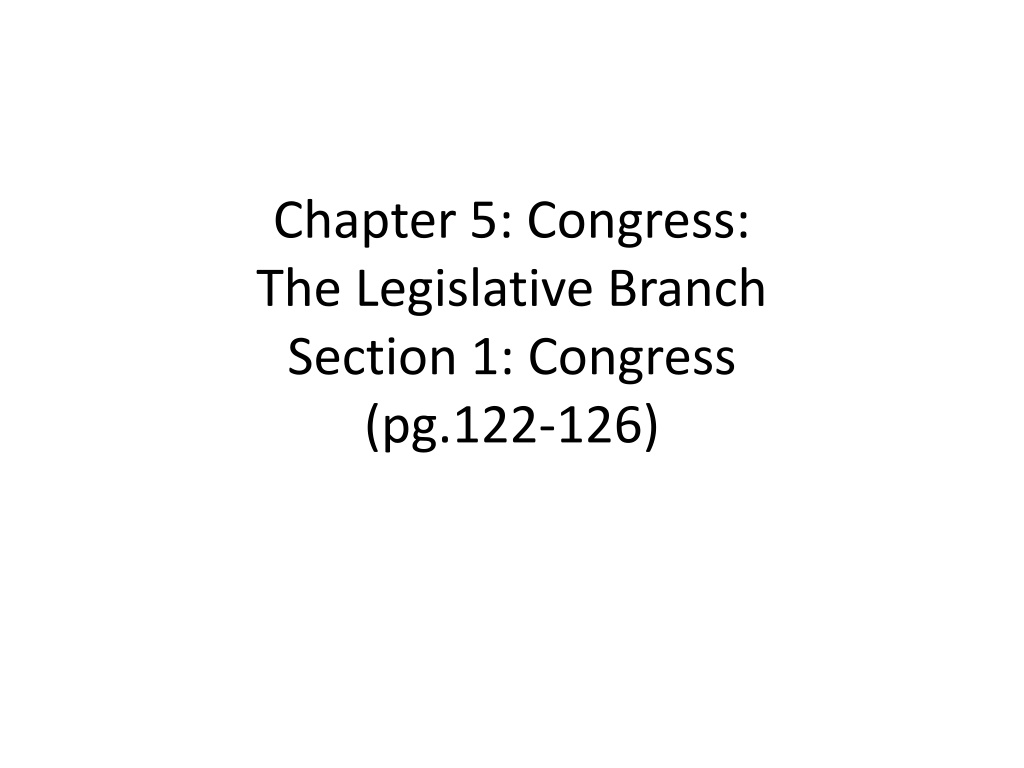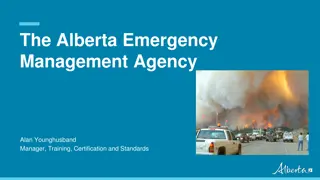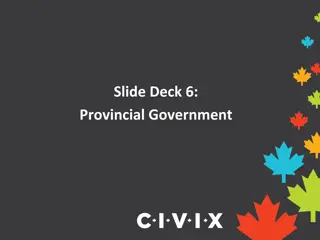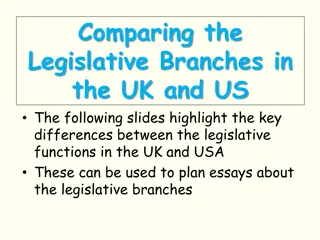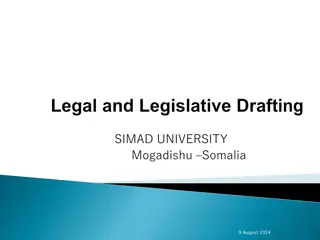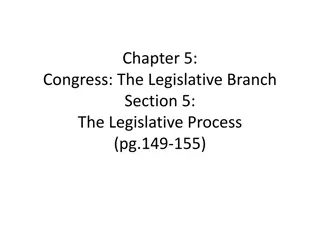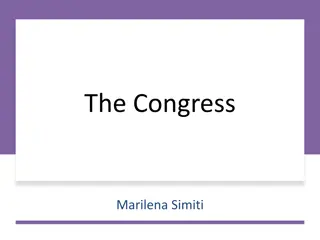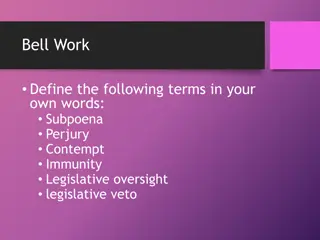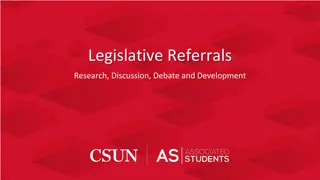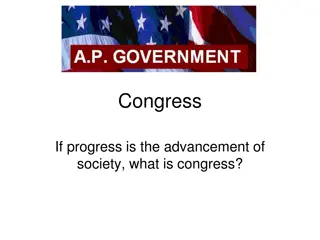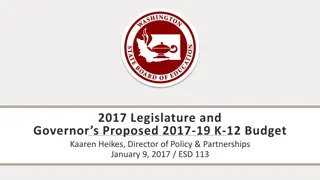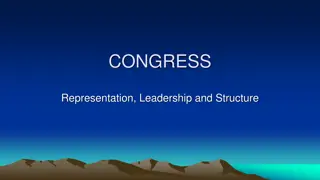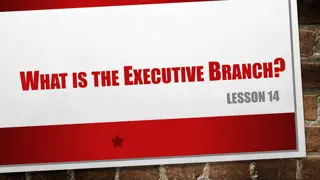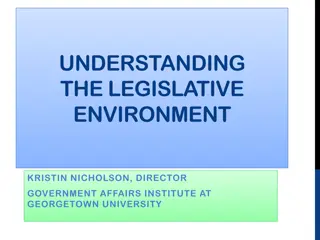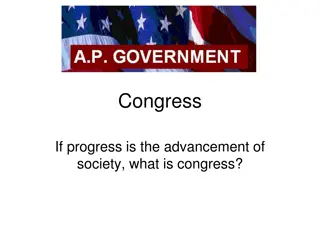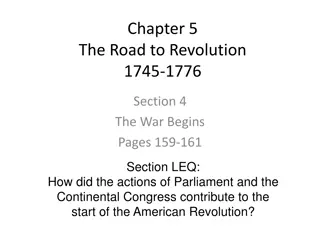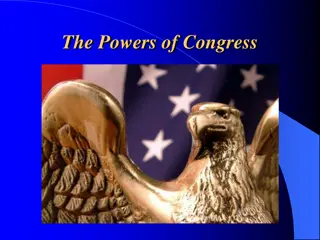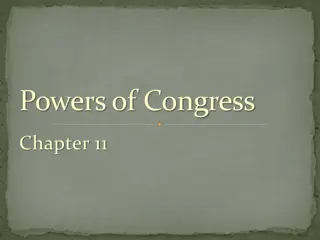Understanding Congress: The Legislative Branch in Action
The legislative branch is embodied in Congress, where representatives elected by the people translate popular will into law. With the House of Representatives and the Senate comprising Congress, discussions explore the dynamics of representation, member demographics, apportionment, and the distinct roles each chamber plays in the U.S. government.
Download Presentation

Please find below an Image/Link to download the presentation.
The content on the website is provided AS IS for your information and personal use only. It may not be sold, licensed, or shared on other websites without obtaining consent from the author. Download presentation by click this link. If you encounter any issues during the download, it is possible that the publisher has removed the file from their server.
E N D
Presentation Transcript
Chapter 5: Congress: The Legislative Branch Section 1: Congress (pg.122-126)
Congress and the People We the People means that the people are sovereign. However, the people do not take part in national government directly. We elect representatives, in regularly scheduled elections to make and carry out the laws. Article I of the Constitution gives law making power to Congress, therefore the U.S. Congress is the body through which the will of the people is made into law. https://encrypted-tbn2.gstatic.com/images?q=tbn:ANd9GcQXZa4o9uhaReXU_zJnPpgwh7VPMjxf7EvvBU3gjVu46t2auJT9sQ
Representing the People https://upload.wikimedia.org/wikipedia/commons/e/ed/Bill_Flores,_Official_Portrait,_112th_Congress.jpg The representative represents the people who live within a geographic area and these people are called constituents. Constituents sometimes have conflicting interests which makes it difficult to represent them. In addition to representing their constituents, members of Congress also keep in mind the need of the country as a whole. Congress is bicameral- meaning two houses, the House of Representatives and the Senate Rep. Bill Flores
Members of Congress http://www.cruz.senate.gov/files/images/OfficialPortrait.jpg Members of Congress tend to be older than the average age-in their mid to late fifties. Most members of Congress are white men. The number who are women, African Americans, Hispanics, or members of other minority groups is low compared to these groups percentage of the general population. Sen. Ted Cruz
The House o Representatives The seats in the House are apportioned by population to each of the states. Apportionment means that each member represents about the same amount of people, around 700,000 In 1929 the number of house seats was locked at 435. They have added nonvoting delegates from DC, Guam, Virgin Islands, & America Samoa. The seats are all contested at the same time, every 2 years, which means that the House can swing from one party to another party after one election. http://chattoogaga.test.sturgiswebservices.com/_fileUploads/US%20House.jpg
The Senate The Constitution fixes membership in the Senate to 2 Senators from each state, t/f there are 50. Originally, the Constitution gave the power to choose senators to state legislatures, but in 1913 the 17th Amendment changed the this to popular vote in each state. The terms are staggered so that a 3rd of the senators are up for election every 2 years. This prevents major changes in membership due to any one election. https://upload.wikimedia.org/wikipedia/commons/f/f8/111th_US_Senate_class_photo.jpg
The Two-House Structure The bicameral legislature was influenced by the British Parliament, that has two houses. It was the Great Compromise. It combined the Virginia Plan that wanted to make both houses based on population and the New Jersey Plan that wanted one house with equal representation. Therefore, the house would be based on population and reflect people s will and every state would get 2 senators picked by state legislatures and serve longer terms The Senate, would be less subject to public passions http://images.politico.com/global/arena/cornyn_john.jpg Sen. John Cornyn
Congress & Checks and Balances The Power of the Purse, meaning that Congress alone has the power to approve spending. They do this by a special act called appropriation. This bill sets aside funds for specific purposes. Congress can stop the other branches of Gov. from spending money on programs it doesn t like. Congress can t lower the pay of the President or judges while they are in office. https://www.e-education.psu.edu/drupal6/files/geog432/images/separation%20of%20power.jpg
Congress & Checks and Balances The Power of Advice and Consent This means that Senate gets to approve treaties with foreign governments. The Senate also has to approve of key government officials, like ambassadors, federal judges and Supreme Court justices. The Senate has not approved treaties that the President has signed and they have also rejected top presidential appointees. http://izquotes.com/quotes-pictures/quote-he-the-president-shall-have-power-by-and-with-the-advice-and-consent-of-the-senate-to-make-constitution-of-the-united-states-304704.jpg
http://www.historyplace.com/unitedstates/impeachments/nix-port.jpghttp://www.historyplace.com/unitedstates/impeachments/nix-port.jpg Congress & Checks and Balances The Impeachment Power- this is when Congress charges officials in the executive and judicial branches with wrong doing and bring them to trail. The process starts in the House where they charge the official with a high crime or misdemeanor, with a majority vote Then the process goes to the Senate, where they hold a trial. A two-thirds vote in required to remove the official from office. https://upload.wikimedia.org/wikipedia/commons/c/ce/President_Andrew_Johnson.jpg http://www.americanheritage1.com/assets/images/presidents/bill-clinton-portrait-victory-pose-1.jpg
Other Checks & Balances The Congress can check the power of the judicial branch by starting the process of amending the Constitution. Congress also has the power to override a presidential veto with two-thirds vote of both houses. (100 times or 4%) Congress also can review how the executive branch is operating, making sure it is following the Constitution. This is called oversight. http://2.bp.blogspot.com/_D3aQrbHeRPc/RzN1JsbSd8I/AAAAAAAAA7k/MlAlYEP4Hcw/s320/override.gif
